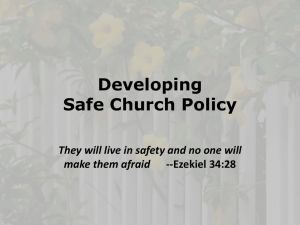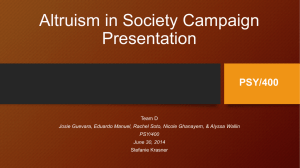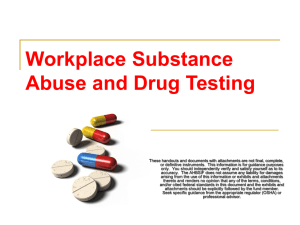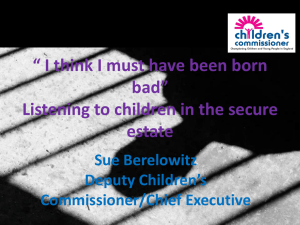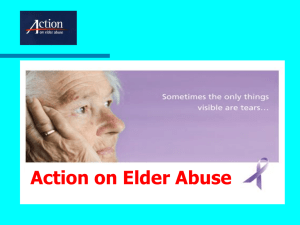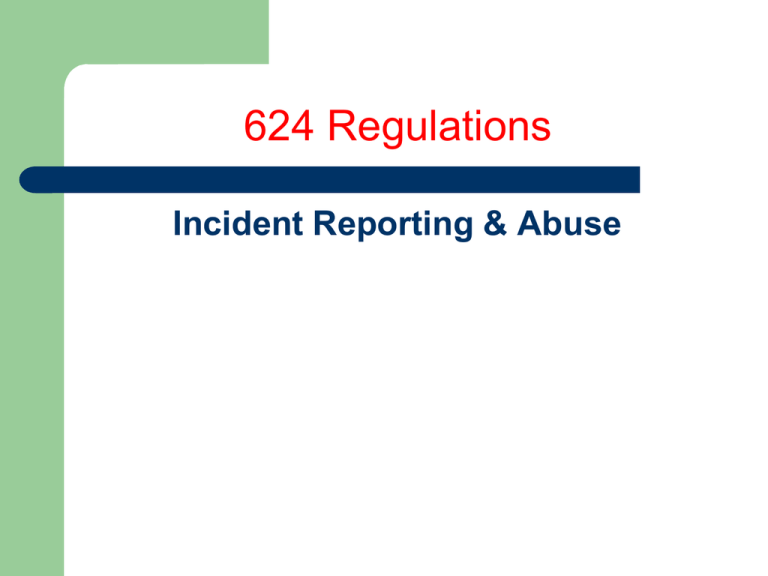
624 Regulations
Incident Reporting & Abuse
What is an Incident?
OPWDD (Office of People With
Developmental Disabilities)" Significant
events or situations endangering a persons
well-being.”
All Incidents are required to be recorded on a
standardized form and are subject to
OPWDD’s approval.
Objective:
To familiarize employees with Heaven’s
Hands Community Service policy and
procedures regarding incident management.
Training Areas:
Incident and their classifications
Distinguishing between reportable, serious
reportable, sensitive situations, minor
occurrence.
Define abuse, discuss prevention of abuse
Outline notification procedures and
timeframes
Why do we report incidents?
To enhance the quality of care for our consumers.
To ensure that consumers enjoy a safe environment.
To identify possible trends and implement
preventative strategies.
To increase agency-wide awareness of incidents in
order to implement corrective measures.
Reporting Responsibilities
All staff, regardless of status are responsible for
the health, safety, and welfare of those individual we
serve. All staff are therefore responsible to report all
incidents.
What constitutes an Incident?
Injury
Missing Person
Death
Restraint
Medication Error
Possible Criminal Act
Sensitive Situations
Abuse/Neglect/Mistreatment
Minor Occurrence:
An incident/injury which requires no more
than First Aid.
Even if it is being provided by a nurse,
physician or other health care professional.
Even if the person goes to the emergency
room.
Reportable Incident:
Any suspected or confirmed harm, hurt or damage
to a person receiving services, caused by an act of
that person or another, whether or not by accident
and whether or not the cause can be identified,
which results in a persons requiring medical or
dental treatment by a physician , dentist, physician’s
assistant or nurse practitioner, as such treatment is
more than first aid. Furthermore the treatment
must revile something. i.e a break, chip, deep cut
Illness is not an injury
Serious Reportable:
Any injury which results in the admission of a person to a
hospital or 24 hour infirmary for treatment or observation
because of the injury.
A serious reportable incident is a reportable incident which
because of the severity or sensitivity of the situation, it must be
immediately reported to OPWDD.
Injury resulting in a hospital admission.
Illnesses are NOT reportable, including psychiatric illnesses.
What classification does the following
incident fall under:
While walking towards the kitchen John fell hitting his left knee.
Carlos the staff member, helped John onto a chair and applied
ice to his knee.
a)
Reportable
b)
Minor Occurrence
c)
Serious Reportable
d)
None of the above
What classification does the following
incident fall under:
While walking towards the kitchen John fell hitting his left knee.
Carlos the staff member, helped John onto a chair and applied ice to
his knee. After monitoring John for approximately 30 minutes, Carlos
sees John knee is still swollen. Carlos escorts John to the
emergency room where the doctor orders x-rays. The x-rays revile
John has a chipped knee cap.
a)
Minor Occurrence
b)
Sensitive Situation
c)
Serious Reportable
d)
Reportable
What classification does the following
incident fall under:
While walking towards the kitchen John fell hitting his left knee.
Carlos the staff member, helped John onto a chair and applied
ice to his knee. After monitoring John for approximately 30
minutes, Carlos sees John knee is still swollen. Carlos escorts
John to the emergency room where the doctor orders x-rays.
After reviewing the x-rays the doctor decides John should
remain in the hospital for observation….
a)
Minor Occurrence
b)
Sensitive Situation
c)
Serious Reportable
d)
Reportable
Missing Person
Unauthorized/Unexpected Absence After Normal
Search Procedures (911) Initiated.
Formal search must be initiated after 4 hour,
reasonable judgment, considering clients habits,
deficits, capabilities, health status, determines when
a search procedure should be implemented. When
client is in danger to themselves or others, A
FORMAL SEARCH MUST START IMMEDIATELY.
Any situation that meets the definition of Missing
Person will always be considered a Serious
Reportable Incident.
Death
All Deaths are SERIOUS REPORTABLES
INCIDENTS. Whether the death is Natural
and/or Unnatural or Unexpected. When
unrelated to known illness or disease,
homicide, suicide, unexplained or accidental.
Restraint
Any device which prevents the free movement of
both arms and/or both legs.
Physical, Mechanical or Medicinal aimed at
controlling BEHAVIORS.
Immobilization of fractures, intravenous drips or
other medical application are allowed as long as they
are being applied/monitored in a hospital setting.
Whenever a restraint is used it is to be reported as a
Serious Reportable Incident.
Medication Errors
Marked, Adverse Side Effects which jeopardizes the
health and welfare of the consumer.
This can be identified as a result from:
Wrong dosage
Wrong form
Wrong application
Wrong patient
Wrong medication
Failing to administer medication
This is classified as a Reportable incident.
Medication Errors
If the consumer is admitted into the hospital
resulting from any of the previously
mentioned infractions, the classification of
the incident MUST change from a Reportable
Incident to Serious Reportable Incident.
Medication Errors
Medication Errors which do not result in
advise effects are not reportable but must be
documented in a persons record.
Possible Criminal Act
Actions by a person receiving services which are or
appear to be a crime.
A crime is defined as “an act that is forbidden by law
that makes the offender liable to punishment
pursuant to the law. In New York State, the Penal
Law defines a crime as a Misdemeanor or a Felony,
but does not include a traffic infraction.”
This falls under the classification of Serious
Reportable Incidents.
Sensitive Situations
A Reportable Sensitive Situation Incident are
situations involving a person receiving
services which are not described previously,
which may be of a delicate nature to the
agency, and which are reported to the
administration to ensure awareness.
Sensitive Situations
A Serious Reportable Sensitive Situation
Incident are those situations which in the
judgment of the chief executive officer, needs
to be brought to the attention of OPWDD,
through the DDSO as expeditiously as
possible.
ABUSE
The definition of ABUSE under 624 Regulations is as
follows:
The maltreatment or mishandling of a person
receiving services which would endanger the
physical or emotional well being of the person
through the action or inaction on the part of anyone,
including an employee, intern, volunteer, consultant,
contractor, visitor, or others, whether or not the
person is or appears to be injured or harmed.
ABUSE
Failure to exercise one’s duty to intercede on behalf
of a person receiving services also constitutes
abuse.
Employees must realize that, should they fail to
intervene in a situation in which they consider a
consumer is being abused, they may be considered
as contributing to the abuse. This includes failing
to interrupt an actual act of abuse or failing to
report such abuse.
Mishandling/Maltreatment
Mishandling: is to manage wrongly or
ignorantly.
Maltreatment: is cruel or rough treatment (or
handling) of a consumer.
WHO REPORTS ABUSE?
Everyone and anyone who observes abuse,
discovers signs of abuse or who hears an
allegation.
Allegation: a claim that somebody has done
something illegal, wrong, or undesirable.
WHEN SHOULD YOU REPORT ABUSE?
Immediately. Even if you are not sure it is
abuse, report what you observed, heard, etc.
so that it can be investigated. It is not up to
the reporter to judge whether it was abuse or
not.
What Should be Reported?
Report the facts. (i.e. what you saw and/or
heard).
Do not draw your own conclusions.
How Should I Report the Abuse?
Verbally, to your supervisor.
DO NOT leave a message.
How Can We Prevent Abuse?
Identifying the signs of stress and burnout.
Learning coping solutions and how to
reframe situations.
Seeking support when needed.
Know your consumer. Recognizing
antecedents, early warning signs.
Be flexible, avoid power struggles.
CATEGORIES OF ABUSE
Physical
Sexual
Psychological
Seclusion
Violation of Civil Rights
Mistreatment
Neglect
CATEGORIES OF ABUSE
UNAUTHORIZED OR INAPPROPIATE USE OF:
Restraints
Aversive Conditioning
Time Out
PHYSCIAL ABUSE
Physical contact which may include, but not limited
to such obvious physical actions as hitting, slapping,
pinching, kicking, hurling, strangling, shoving,
unauthorized or unnecessary use of personal
intervention.
Physical contact which is not necessary for the
safety of the person and/or causes discomfort to the
person may also be considered to be physical
abuse.
PHYSICAL ABUSE
Any intentional hitting, slapping, pinching, kicking, hurling,
strangling or shoving of an individual receiving services
by a staff member, intern, contractor, consultant or
volunteer of a DDSO or provider entity, except for those
instances in which the action was taken to prevent injury
to the individual receiving services or any other person,
whether or not such action causes injury, may be a crime
and must be reported to law enforcement.
PHYSICAL ABUSE
Any intentional hitting, slapping, pinching, kicking, hurling,
strangling or shoving of an individual receiving services
by another individual receiving services, where the
individual who performs the abusive action intends to
cause physical injury to the other individual and causes
such physical injury, may be a crime and must be
reported to law enforcement. Physical injury is defined as
impairment of physical condition or substantial pain.
PHYSICAL ABUSE
Any unauthorized or unnecessary use of restrictive
personal intervention techniques, including the use of
more physical force than is necessary for the safety of the
individual receiving services, by a staff member, intern,
contractor, consultant or volunteer, where the staff
member, intern, contractor, consultant or volunteer
knowingly acts in a manner likely to cause injury to the
physical or mental welfare of the person receiving
services, may be a crime and must be reported to law
enforcement
PHYSICAL ABUSE
Physically forcing a person, who refuses to take a
medication would be considered physical abuse.
Any unauthorized or unnecessary use of restrictive
personal intervention techniques, including the use of
more physical force than is necessary for the safety of the
individual receiving services, by a staff member, intern,
contractor, consultant or volunteer, where the staff
member, intern, contractor, consultant or volunteer
knowingly acts in a manner likely to cause injury to the
physical or mental welfare of the person receiving
services, may be a crime and must be reported to law
enforcement.
.
PHYSICAL ABUSE
Any unauthorized or inappropriate use of restraint where
the staff member, intern, contractor, consultant or
volunteer knowingly acts in a manner likely to cause
injury to the physical or mental welfare of the person
receiving services may be a crime and must be reported
to law enforcement. This includes the use of mechanical
restraining devices or medication to control a person’s
behavior without the necessary permissions
SEXUAL ABUSE
Any sexual abuse, as defined by 14 NYCRR Part
624.4(c)(2), between a person receiving services and an
employee, intern, consultant, contractor or volunteer of an
agency may be a crime and must be reported to law
enforcement.
Sexual contact is defined as the touching or fondling of
the sexual or other intimate parts of a persons for the
purpose of gratifying the sexual desire of either party,
whether directly or through clothing.
Any sexual contact between two persons receiving
services in which one person receiving services uses
force or coercion may be a crime and must be reported to
law enforcement.
PSYCHOLOGICAL ABUSE
The use of verbal or non-verbal expression, or other
actions in the presence of one or more persons
receiving services that subjects the person (s) to
ridicule, humiliation, or scorn, contempt or
dehumanization. In addition to the language and/or
gestures, the tone of voice, such as that used in
screaming or shouting at the presence of persons
receiving services, may in certain circumstances,
constitute psychological abuse.
SECLUSION
The placement of a person in a secured
room or area from which he or she cannot
leave at will.
Note: This does not include TIME OUT as
part of a behavior management plan.
UNAUTHORIZED OR INAPPROPRIATE USE
OF RESTRAINTS
Use of mechanical restraining devices
without the written prior physicians
authorization without it being specified in a
plan of service, or used for medical purposes
without a physician's order.
The intentional use of a medication to control
a persons behavior that has not been
prescribed by a physician.
UNAUTHORIZED OR INAPPROPRIATE USE
OF Aversive Conditioning
The use of adverse conditioning without
appropriate permission is the unauthorized
use of aversive conditioning. Inappropriate
use of aversive conditioning shall include, but
not limited to, the use of the technique for
convenience, as a substitute for
programming, or for disciplinary
(punishment) purpose.
UNAUTHORIZED OR INAPPROPRIATE USE
OF TIME OUT
The use of Time Out without appropriate
permission is the unauthorized use of Time
Out. Inappropriate use of Time Out shall
include, but not limited to, the use of the
technique for convenience, as a substitute for
programming, or for disciplinary
(punishment) purpose.
Time out should not be confused with
seclusion.
VIOLATION OF A PERSONS CIVIL
RIGHTS
Any action or inaction which deprives a person of the
ability to exercise his or her legal rights.
Civil rights are those rights stipulated in State or
Federal law for all persons in the United States, as
such but not limited to the right to be free from
discrimination, the right to vote, the right of children
to education, and the right of disabled person to
access public buildings.
MISTREATMENT
The deliberate and willful determination of an agency
or staff to follow treatment practices contraindicated
a person’s plan of service, which violates a person’s
human rights or does not follow accepted treatment
practices and standards in the field of developmental
disabilities.
The denial of programming, socialization, recreation,
etc. might be categorized as abuse in the form of
mistreatment.
NEGLECT
A condition of deprivation in which persons receiving
insufficient, inconsistent or inappropriate services,
treatment, or care to meet their needs.
Failure to provide appropriate and/or safe
environments for persons receiving services.
Failure to provide appropriate services, treatment, or
care by gross error in judgment, inattention, or
ignoring may be considered a form of neglect.
IS THIS ABUSE?
It’s 9:00 pm and Maria, DCC assist her consumers with their
showers and puts two residents to bed in the room they share
and shuts the door. The consumers keep getting up from their
beds and opening the door. Maria decides to put a chair in
front of the door and holds the door shut to prevent the
consumers from leaving their room.
Is this abuse, and if so what kind?
Thirty five year old Janet has been trying to make her own
sandwich for months. One afternoon she successfully
completes the task and proudly approaches a staff who says
“Big deal” and throws the sandwich in the garbage and walks
away.
Is this abuse, and if so what kind?
IS THIS ABUSE?
While Roseanne, a twelve year old consumer is watching T.V.,
Tom, the DCC begins to tickle her. Roseanne doesn't like it
and repeatedly asks Tom to stop. Tom says “ You’ve been so
quiet today”, and continues to tickle Roseanne.
Is this abuse, and if so what kind?
Tom is a consumer who enjoys going to church every Sunday.
This particular Sunday it is raining outside and staff tells Tom
he would not be going to church today because it is raining.
Is this abuse, and if so what kind?
REPORTING AN INCIDENT
CHAIN OF COMMAND
Carmella McDonald, Dir. of Clinical Services
646-919-8890
Kimberlyn James,
Program Manager
917-682-9819
Daniel Rodriguez,
Dir. Of Day Hab Services
347-756-8851
Marie Saintelmy
Dir. Of QA & Corp Comp.
718-809-0721
Arlene Rado,
Deputy. Ex Dir. of Pro Oper.
Child Abuse Hotline
718-864-0228
800-635-1522
CHILD ABUSE & NEGLECT
Mental Health Professional is one of the many professions
recognized by the New York State Social Services Law Section
413 to be specially equipped to hold the important role of
Mandated Reporter of child abuse or maltreatment.
Mandated Reporters are required to report instances of
suspected child abuse or maltreatment only when they are
presented with reasonable cause to suspect child abuse or
maltreatment in their professional roles. Therefore, if the Doctor
is examining a child in her practice and has a reasonable
suspicion of abuse she must report it. However, the doctor who
witnesses’ child abuse when riding her bike on the weekend is
not mandated to report that abuse. (Of course, anyone may
report any suspected abuse at any time, and is encouraged to
do so.)
CHILD ABUSE & NEGLECT continue…
As a staff member of Heaven’s Hands
Community Services. you are a mandated
reporter.
RECOGNIZING CHILD ABUSE &
NEGLECT
Signs and Symptoms of Child Abuse and Neglect
Child abuse and neglect occurs in all segments of our society,
but the risk factors are greater in families where parents:
Seem to be having economic, housing or personal problems.
Are isolated from the community.
Have difficultly controlling anger or stress.
Are dealing with physical or mental health issues.
Abuse alcohol or drugs.
Appear uninterested in care, nourishment or safety of their
children.
RECOGNIZING CHILD ABUSE &
NEGLECT
The behavior of children may signal abuse or neglect long before
any change in physical appearance. Some of the signs may
include:
Nervousness around adults.
Aggression towards adults or other children
Inability to stay awake or concentrate for an extend period of
time.
Sudden dramatic changes in personality or activities.
Unnatural interest in sex.
Frequent or unexplained bruises or injuries.
Low self esteem.
Poor Hygiene.
CHILD ABUSE & NEGLECT
continues…
Procedures
When a staff member makes report in their capacity
as members of the staff of a medical or other public
or private institution, school, facility or agency, they
are required to report the abuse to the Statewide
Central Register Child Abuse and Maltreatment
THEMSELVES DIRECTLY.
The law requires that only one report from the
institution, school or agency be made.
HHCS reporting procedures on CHILD
ABUSE & NEGLECT
Staff who witness the abuse must report the abuse
directly to Statewide Central Resister for Child
Abuse and Maltreatment.
After which they should contact their supervisor..
Oral report by Mandated Reporter is to be made to
the State Central Register at 1-800-635-1522.
A signed, written report OMR 147 must be filed
within 24 hours of an oral report.
CHILD ABUSE & NEGLECT
continues…
Penalties for Failure to Report (apply to mandated reporters
only) or False Allegation
Criminal Sanction: It is a Class A Misdemeanor for a mandated
reporter to willfully fail to report a case of suspected child abuse
or maltreatment. The maximum penalty for a Class A
Misdemeanor is 1 year in jail and a $1,000 fine.
Civil Sanction: A mandated reporter who knowingly and
willfully fails to make a report of suspected child abuse or
maltreatment is civilly liable for damages caused by such
failure.
Immunity from Liability for Good Faith Reporting
When a report is made in good faith, the reporter is immune
from civil or criminal liability.
INJURY OF UNKNOWN ORIGIN
The purpose of this outline is to address:
The purpose for conducting an investigation
into Injuries of Unknown Origin.
When do we complete an inquiry into an
injury of unknown origin report?
What does it take to complete a thorough
inquiry?
INJURY OF UNKNOWN ORIGIN
Simply stated, inquires into injuries of unknown origin are completed
because we don’t know how the injury occurred. As specified under
624 regulations , all reportable incidents, classified as injuries of
unknown origin must be thoroughly investigated by the program.
We need to attempt to find out how the injury happened because we
may be able to prevent it from reoccurring to either the same
consumer or to someone else.
Having knowledge enables us to be proactive and as we all know
being proactive is always better than being reactive.
There have been plenty of examples where a complete and thorough
inquiry has shown the cause of an injury and prevented many others.
Many experiences, even negative, can be used as a learning
experience. Remember, the consumer’s safety is your primary
concern.
INJURY OF UNKNOWN ORIGIN
When do we do an injury of unknown
origin?
We need to complete an inquiry injury of unknown
origin for all. injuries classified under 624 regulations
as “Reportable Injury-Unknown Origin. As you know
we file a “147-I” report for someone whose injury
requires attention “ above and beyond first aid” It
is our responsibility to thoroughly investigate the
injury.
INJURY OF UNKNOWN ORIGIN
We may encounter a bruise, mark, scrape on
someone’s body that only requires first aid, but
needs to be looked into. In this instance, we need to
train staff to notify their supervisor immediately so
that as assessment of the situation can be made and
a determination whether an inquiry must be initiated.
Think about the times that you have noticed a mark
on your body and though how did this happen and
tried to determine the cause of it! That is what we
must do for our consumers who are unable to recall
and/or express the cause of an injury.
INJURY OF UNKNOWN ORIGIN
What does it take to complete the report
thoroughly?
The key is to remember that you need to speak with
any and everyone who could possibly know what
may have caused the injury.
Always err on the side of caution, because it is
always better to have interviewed too many people
than not enough. It is important to remember that
you don’t know when the incident could have
happened.
INJURY OF UNKNOWN ORIGIN
WHO SHOULD I INTERVIEW?
Talk to the consumer
Talk to all staff on duty at the time the injury was discovered.
Depending on how old the injury is, talk to people who worked
on different shifts the same day and maybe even the day prior.
Talk to people who transport the individual(s).
If applicable, talk to day program, OPTS/ In home behavioral
personal.
Talk to parents/siblings
INJURY OF UNKNOWN ORIGIN
The purpose of speaking with people is to gather information about
what could have happened to cause this injury. You want to learn
from staff whatever relevant information they possess about the
incident and eventually you’ll need them to write it down for you.
Written statements are VERY important. The person conducting the
inquiry should start by asking all staff on shift at the time of discovery
to write a statement, date and SIGN it. These statements will be kept
on file with the complete injury report.
After you’ve compiled all the information, read it through and begin
completing the report. The person completing the inquiry into the
unknown origin form should transcribe a summary of each person’s
statement. Meets with your supervisor/ Coordinator of QA to discuss
corrective action or whether additional follow-up is necessary. Your
report is not complete until a supervisor and the Coordinator of QA has
reviewed it.


